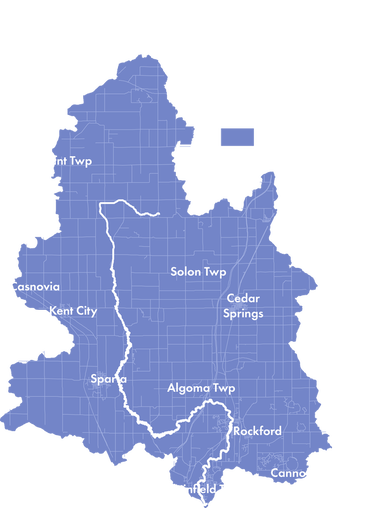The Mission of the Rogue River Watershed Partners is to Protect, Preserve, and Promote the Rogue River, its Tributaries, and its Watershed. We work to achieve this mission through community stewardship, education, and watershed-based, land-use planning. We envision a healthy, life-giving Rogue River that is sustained by residents of this watershed, including the towns, townships, businesses, farmers/ producers, and outdoor enthusiasts who are privileged to live near, and who benefit from, this priceless resource.
|
What is a Watershed?
A watershed is an area of land in which all captured water shares a common outlet. The map above shows all of the land area within the Rogue River Watershed. Any water that falls within the Rogue River watershed will eventually drain into the Rogue River. Watersheds are defined by their lowest elevation. As gravity pulls water downward the water collects in a lake, river, or stream (the lowest areas of the watershed).
|
What is a Tributary?
Larger watersheds are often made up of smaller watersheds (and are also part of larger watersheds themselves). The Rogue River is fed by 8 smaller streams. These streams are known as tributaries to the Rogue River. Each of these tributaries has their own watersheds, known as sub watersheds, as seen on the map to the right.
Where does the Rogue River flow?The Rogue River is fed by its tributaries and is a tributary itself to a larger water feature, the Grand River. The map below shows all the watersheds that feed into the Grand River including the Rogue River. The organization "Lower Grand River Organization of Watersheds" (LGROW) coordinates conservation efforts between all the watersheds that feed into the Grand River. You can visit LGROW's website here for more information. Additionally the Grand River, into which the Rogue River drains, is also part of a larger watershed, namely the Lake Michigan Watershed.
|
Why is Protecting, Preserving, and Promoting our watershed important?Everything that happens within our watershed impacts our neighbors and one of our State's greatest marvels, Lake Michigan. Pollutants in any area of the Rogue River Watershed can eventually make their way into the Rogue River. This includes things like oil on a road, chemicals in a lawn, nutrients from animal waste, sediments etc. As water falls within the watershed it begins to drain into the water body picking up different pollutants as it moves across the landscape.
By working within our community to improve the health of our watershed we are actively creating a cleaner and healthier place to live for our community and those communities that the Rogue River's water eventually reaches. Did you know that the Rogue River and its tributaries are also protected under Michigan's Natural Rivers Act? Learn more here. |



